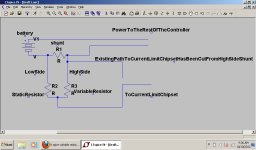Jeremy Harris
100 MW
Wurly said:Am i correct in thinking that by adding a pot in parallel with r45 (2k) i can reduce the current limit?
This way i can reduce current by adjusting one pot, and increase current by another pot (using your mod)
Yes, reducing the value of R45 will reduce the battery current limit, but it's already pretty low, just 12 A as standard, so would you really want to decrease it below that figure?
If you wanted to increase the adjustment range then just use a fixed resistor across R45 to reduce the value (and hence battery current limit) and then use the new pot to gain a wider range of adjustment.


